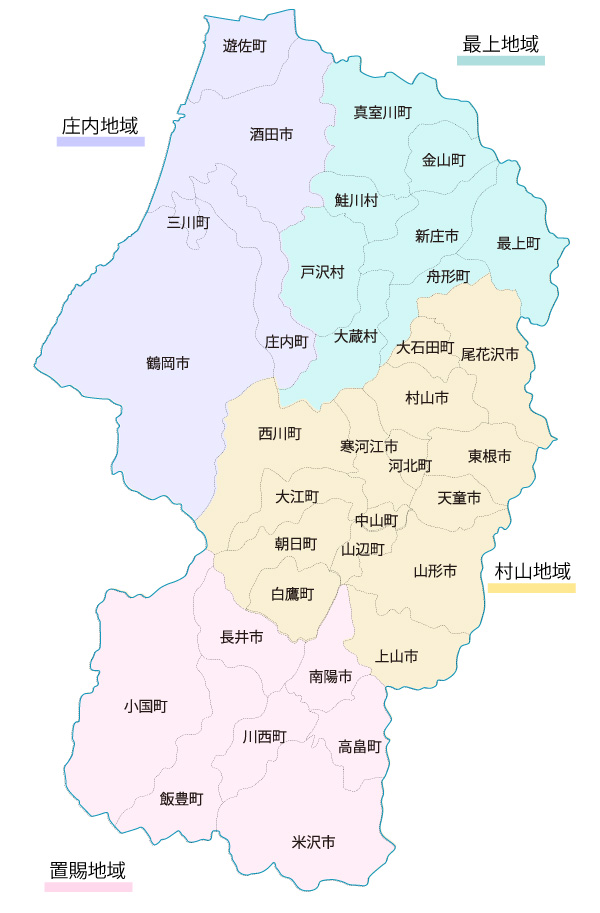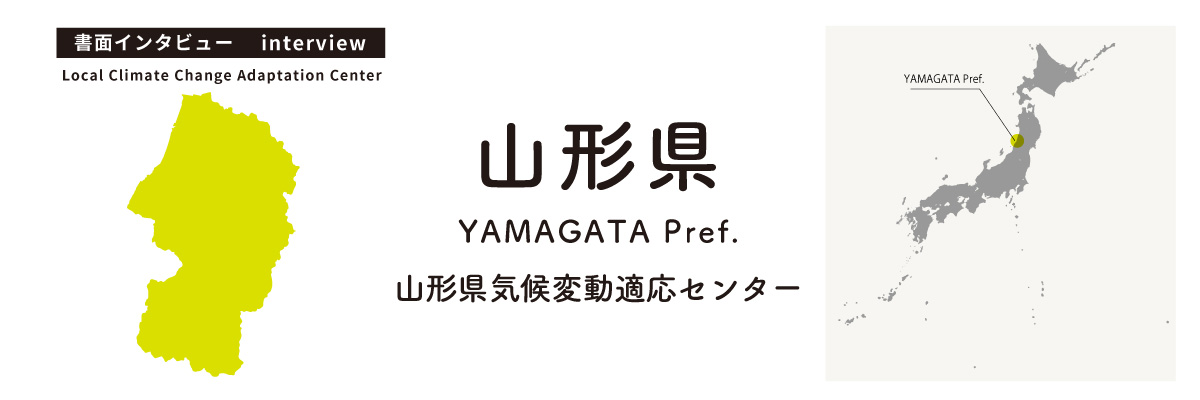Please tell us about Yamagata Prefecture’s unique local features and characteristics, what led to the establishment of the Local Climate Change Adaptation Center, and what its organizational structure is like.
Yamagata Prefecture is divided into four regions called Murayama, Okitama, Mogami, and Shonai, each of which has distinct topography that is mainly a basin, mountainous, or coastal, giving them different meteorological and climatic characteristics. As such, the people living in each of these regions might have a different perception of what climate change is and what it means to them, so we believe it will be important for us to implement a set of adaptation measures that are suitable for each region.
Yamagata Prefecture formulated its fourth-phase comprehensive environmental plan in March 2021 covering diverse initiatives to protect the environment, which also includes a climate change adaptation plan and the establishment of a local climate change adaptation center pursuant to Articles 12 and 13 of the Climate Change Adaptation Act, respectively. Subsequently, Yamagata Prefecture opened its Climate Change Adaptation Center on April 1, 2021 according to plan.
As the Environmental Science Research Center of Yamagata Prefecture had already been taking the lead in related activities such as provision of environmental education including how to tackle global warming, library service to spread literature on the environment, and other forms of information, it was decided after thorough contemplation that it would be optimal to set up the Yamagata Prefectural Climate Change Adaptation Center within the Environmental Science Research Center.
In terms of the organizational structure, the Climate Change Adaptation Center is being operated by the Environmental Planning Department that oversees environmental education and other related activities, and has a staff of four including the Director, two Deputy Directors, and four Environmental Planning Department members.

Please tell us about the current activities of Yamagata’s Local Climate Change Adaptation Center as well as its future plans.
While the main function of the Local Climate Adaptation Center is to gather and disseminate information related to climate change adaptation, we believe there are two key requirements that we must consider in order to successfully execute this function. The first requirement is that we must gather diverse information in all interconnected areas, ranging from basic facts to advanced science in particular specialties, digest them into easy-to-understand nuggets of information, and communicate them to the prefectural residents, while organizing such pool of information that is readily accessible to them depending on the type of information they are looking for. The other requirement is we must provide advice and support through information dissemination in such a way that is optimized for each region to implement adaptation measures suitable for its unique regional characteristics.
As for the first requirement, we are actively gathering information and offering environmental classes and on-site lectures for information dissemination to prefectural residents while making improvements every day. We have held such events roughly on 10 different occasions and will be offering more in the future.
In terms of the other requirement of facilitating regional activities, which is quite a challenging task, we hosted our first workshop-style seminar this past December to start off the process. We chose the workshop format because a lecture-style seminar would only lead to one-way communication, which would prevent us from hearing the voice of prefectural residents. As a result, the event attendees expressed their opinions as to what how they felt about the topic in their daily lives, etc. more than we had hoped for. So we are sifting through them to identify what are being required of government service with the implementation of regional adaptation measures and planning on applying the insight to our future activities.
In addition, we will continue the seasonal biological monitoring that has been an ongoing project of the Tohoku Regional Council on Climate Change Adaptation, of which we are a member, and accumulate and publish the data. However, as explained above, Yamagata Prefecture is made up of the regions that have significantly different meteorological and climatic characteristics, we want large numbers of prefectural residents to participate in this monitoring and consciously experience the climate change that is occurring in their surroundings, so that we can eventually facilitate adaptation measure implementation at individual level.
Please tell us about any unique approach that your Local Climate Change Adaptation Center is taking to effectively coordinate with other departments of the Yamagata Prefectural Government and to facilitate adaptation by the prefecture and businesses, as well as any issues, etc. you are experiencing.
When it comes to climate change adaptation, especially concerning disaster prevention and mitigation, it would be crucial to implement measures at regional level, for which municipalities must actively get involved.
Therefore, we believe that the crucial role of the prefecture is to use the Local Climate Change Adaptation Center to not only disseminate information but also continuously provide advice and support to municipalities so that their regional organizations can conduct related activities in such a way that is suitable for each region.
Please tell us what motivates you to do your current work and also your outlook on the future.
As the objects of investigative research on climate change usually tend to be broad and far-reaching, not many research topics exist that should be handled at prefectural level. So what the Local Climate Change Adaptation Center might be required to do is to facilitate regional activities, and we believe it would be important for us to educate the prefectural residents on the concepts of mitigation and adaptation in addressing climate change and make them part of our common culture. For this purpose, we must contemplate how best to utilize the environmental education programs that were previously used, and improve and implement them widely.
Apart from investigative research, we would formulate and execute plans that would effectively raise public awareness on the distinct concepts of adaptation and mitigation, and allow prefectural residents to put the knowledge to practice somehow, for which we will be referencing the cases of other municipalities as well as information that is available on A-PLAT, etc.
(Posted on February 4, 2022)


